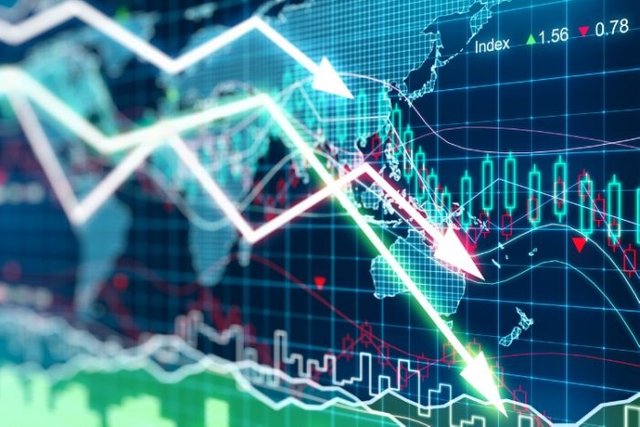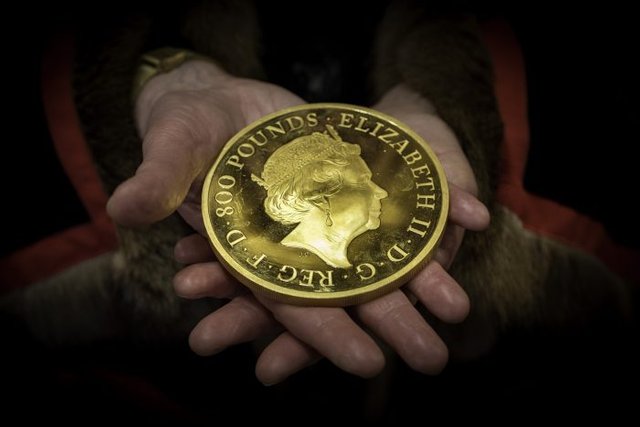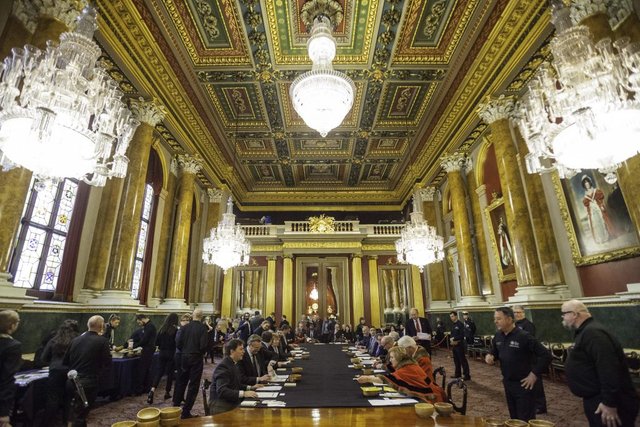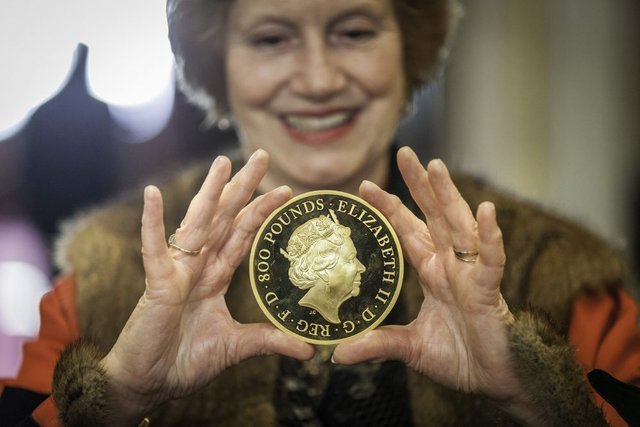!! Gold rises as global markets plummet !!
Stock markets around the world have lost $4 trillion in value over the last week and continue to see record sell offs, prompting a rise in the gold price as investors seek a safe haven
A significant stock-market sell off has seen the price of gold rise. The US Dow Jones lost 4.6% of its value overnight, a dive mirrored in Asia and Europe this morning. Japan’s Nikkei 225 was down 4.7%, while Frankfurt, London, and Paris reported losses of around 3%.

The nosediving markets represent a sell-off of $4 trillion over the last eight days, following previous record highs. “Playtime is officially over, kids,” analysts at Rabobank told Reuters. “Rising volatility painfully reminds some investors that one-way bets don’t exist.”
The downturn has seen a rise in the gold price to $1,342.95 per ounce this morning, following earlier gains on Monday. But other commodities suffered as Brent crude oil’s international benchmark futures hit a one-month low before recovering to stand at $67.28 per barrel, down 0.5 percent on the day.
Market sentiment currently seems to be one of the adjustments as investors look to price in inflation and interest rate rises following a strong wage growth report in the US. A backdrop to this has been the continued strong performances of stock markets for well over a year. For many speculators this is a result of quantitative easing and the flooding of markets with money by central banks, resulting in an “asset bubble” as investors use cheap money to offset low bond-yields by investing in assets.
That ongoing rise has led to a lack volatility which is now returning to bite. “The difference between this year and last year is we’re going to see more periods of volatility like this as the market reacts to higher inflation,” Joel Prakken, chief US economist for IHS Markit, told the BBC. “We’re just not used to it because it’s been so long since we’ve had a significant correction.”
Whether this market adjustment heralds a wider problem for investors is yet to be seen. The advent of quantitative easing twinned with a pro-longed bull market has been seen by some as the markets gearing up for an inevitable fall. However, there were some who stressed a downturn is an opportunity for those wanting to buy to start spending: Michael Strobaek, Global CIO at Credit Suisse, told clients:
“We still consider the equity bull market to be intact and to have the potential to go further. Yet, as we have said on numerous occasions, the bull market is not going to be as good as what we saw in 2017, and it will be associated with high levels of volatility, as short rates and now yields have left their bottoms and are moving higher. We see the latest developments as a healthy correction that offers a buying opportunity for clients who wish to deploy cash.”
Mining.com reported that many investors had deployed into gold, saying the yellow metal has gained $90 an ounce since mid-December. According to the website, hedge funds have also sought gold, more than doubling their net long positions – bets that gold will be more expensive in future – to the equivalent of 21.4 million ounces.
Institutional investments in gold-backed exchange traded funds (ETFs) have also continued to grow. Last week ETF vaults held 2,255 tonnes or 72.5m troy ounces, levels last seen May 2013, as investors move into the safety of gold and away from the eruption of volatility in the markets.
Seven hundred years on the Trial of the Pyx still holds value

The ceremonial phenomenon know as Trial of the Pyx took place last week in London’s Goldsmiths’ Hall, marking the continuation of a 770-year tradition and showing the lasting heritage behind verified money
In the City of London they’re counting your money. Beneath the ornate painted ceiling of the Goldsmiths’ Company Hall a number of selected jurors are counting and weighing the coins of the realm, carrying out an annual assessment that dates back to 1248. This little known, arcane phenomenon is known as the Trial of the Pyx and it marks the official judgement of the UK’s coinage.
The Goldsmiths’ Company’s deputy clerk, Nick Harland, explains the history of the Trial to the 60 or so gathered spectators. It began during the reign of Henry III when, having ordered the Royal Mint to undertake a re-coinage act, he needed an independent judicial review to make sure his money really was all sterling silver and gold and that its weight was as stated.
This job was given to the mayor and “the discreet and lawful men of the City of London” who would begin the Trial by opening the “pyx”, or the small strongboxes within which the coins were kept. In 1580 Elizabeth I made the Trial the responsibility of the Goldsmiths’ Company who used to visit the Exchequer in Westminster every year, until 1870 when the whole shebang was moved to their hall on Foster Lane off Cheapside, where it has been ever since.

The Trial underway Image © The Goldsmiths’ Company. Photography by Richard Lea-Hair.
Today, the operation remains largely unchanged. Jurors are chosen from the ranks of the Goldmsiths’ Company and before the Trial are reminded of their duty by the Queen’s Remembrancer: the oldest judicial post in existence in the UK and a post that predates even the Trial. Created in 1154 it was the Remembrancer’s job to keep a record of the King’s fiscal dealings. Today the post is held by Barbara Fontaine, the first female Remembrancer in its 864 year history. Following her speech the Jurors then spend an hour or so counting out ten of each type of coin that was minted the previous year, selecting one from each batch to be weighed. The feast of numeraire scrutiny then continues next door in the drawing room, where each set is counted using counting machines.
There is also a more technical aspect to the Trial: the London Assay Office, also located at the Goldsmiths’ Hall, undertake laboratory testing of the coins to confirm their metallic make-up. Melting them down and x-raying them to compare them against the official weights and measures issued by the National Measurement Office, a concept which itself dates back to Magna Carta in 1215. Once this has taken place the Verdict can then be read, this usually happens several months later, back at the Goldsmiths’ Hall and in the presence of the Chancellor of the Exchequer, who now fulfils the role of Master of the Royal Mint.
“It’s fair to say that if the Trial didn’t exist today we probably wouldn’t invent it,” says Harland. “We’re here to safe-guard the value of the coins of the realm, but just up the road is a chap with a little button on his desk and he presses it and out of thin air comes billions and billions of pounds.”
Nevertheless, safe-guarding value is crucial to the coin collectors that make up a large part of the Royal Mint’s customer base. Royal Mint employees are on hand throughout to facilitate the testing of around 25,000 individual coins. Some are those you’d see in circulation but most are the high-end collectors’ items such the Chinese Lunar Year set, the platinum ‘Britannia’ and the 1kg solid gold ‘Queen’s Beasts’ which retails at £49,995. Other highlights minted in 2017 include coins commemorating the works of English novelist Jane Austen and the legacy of scientist and former master of the Royal Mint, Sir Isaac Newton.

Prime Warden Judith Cobham Lowe with an £800 Commemorative Gold Coin. Image © The Goldsmiths’ Company. Photography by Richard Lea-Hair
Speaking outside the ongoing Trial in the sunlit drawing room of Goldsmiths’ Hall, Harland identifies the biggest threats to the mechanisms of heritage on display. Most are logistical ripples such as lost coins turning up in Jurors’ turn-ups. Some are more fundamental though: “I suppose where the trial is potentially vulnerable in its current state, is with the introduction of contactless payment – but we’re quite a way from that yet. We’ve just produced millions, of millions, of new £1 coins, they will be in circulation for many, many years. But, just like with oil, eventually we won’t be using nearly as much of it. The macro-trends, the strategic trends, may change the nature of money.”
The historical repercussions of certain macro-trends are highlighted by the Queen’s Remembrancer, Barbara Fontaine, in her speech to the Jury. She mentions The Netherlands’ Tulip-Mania, the City of London’s South Sea Bubble and the global crashes of 1929 and 2007/08, as well as the recent mania behind cryptocurrency. “We live in interesting, challenging and exciting times, as human beings have probably always done so. We have much to be grateful for, not least the continuation of our traditions,” she advises. Such works make clear the Trial believes the contrast between contemporary challenges and tradition is its own testimony.
https://glintpay.com
...Thanks for watching...